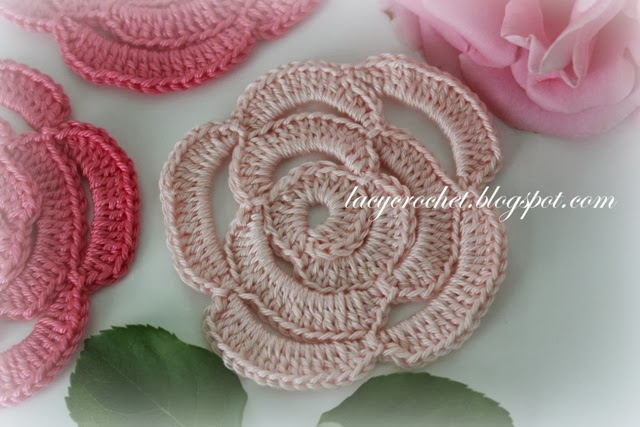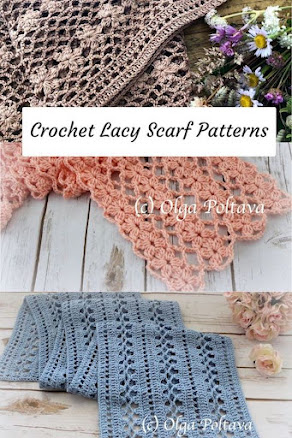Whenever
I make a new baby blanket, I also try to come up with a matching baby hat
pattern. A handmade baby blanket makes a nice gift, but a baby blanket and a
hat make even nicer gift set.
So
here is a free crochet pattern for a baby hat made in same stitch as the Green Baby Blanket. As I was making it, I aimed for a smaller size (either newborn or
3-6 months), but my baby hat came out quite bigger than intended. It measures
about 17 inches in diameter and 7 inches in height, which would be a 6-12 months size.
Since
until now I didn’t have any baby hat patterns in this size, I decided not to
remake/rewrite the pattern. Besides, this is not an easy pattern and it took me
a lot of work and figuring out.
So I stress it out again, it's a difficult pattern; in fact, it's the most difficult one of all the hats I made and wrote patterns for. If you are a beginner crocheter, this is not the best project to start. Check out other free baby hat patterns on Lacy Crochet.
This pattern is my original design. It cannot be posted on other
sites or distributed in any other form. If you would like to share this
pattern, you can post ONE image on your site with the link to my original post.
You can use this pattern to make items for personal use or for sale. If you
sell finished items from this pattern, you must give design credit to Lacy
Crochet blog (lacycrochet.blogspot.com). Please, respect my work. Thank you!
Skill
Level: Advanced
Snuggly
Wuggly by Loops and Threads
US
hook G/6
Gauge:
3 first rounds measure 3.75 inches
V-stitch:
(dc, ch 1, dc) worked all in the same space or stitch.
In
this pattern, V-stitches are worked either
into
V-stitches of the previous round (that is, into ch-1 space between 2 dc) or
into
space between two V-stitches of the previous round (that is, into space prior
to next V-stitch).
Ch
5, join with sl st into ring.
Round
1: Ch 4, *dc in ring, ch 1* 11 times. Join with sl st into 3rd ch of beginning
ch-4.
Round
2: Sl st into next ch-1 space, ch 4, dc in same ch-1 space, V-st in each ch-1
space around. Join with sl st into 3rd ch of beginning ch-4.
Round
3: Sl st into next ch-1 space, ch 4, dc
in same ch-1 space, V-st into next space between two V-st of previous round,
*V-st into next 2 V-st, V-st into next space between two V-st of previous
round* 5 times, V-st into next V-st. Join with sl st into 3rd ch of beginning
ch-4.
Round
4: Sl st into next ch-1 space, ch 4, dc in same ch-1 space, V-st into each V-st
around. Join with sl st into 3rd ch of beginning ch-4.
Round
5: sl st into next ch-1 space, *ch 1, (2-dc cluster, ch 1, 2-dc cluster, ch 1,
2-dc cluster) all in next V-st, ch 1, sc in next V-st* around. In the last
pattern repeat, make last sc in space where sl st in the beginning of the round
was made.
Round
6: ch 2, dc in next ch-1 space, *ch 1, sc in next ch-1 space, ch 3, sc in next
ch-1 space, ch 1, 2dctog over next two ch-1 spaces* around. In the last pattern
repeat, don’t make 2dctog, but make sl st into space between beginning ch-2 and
dc.
Round
7: (ch 2, dc, ch 1, 2-dc cluster, ch 1, 2-dc cluster) all in same space where
sl st was made, *ch 1, sc in next ch-3 space, ch 1, (2-dc cluster, ch 1, 2-dc
cluster, ch 1, 2-dc cluster) all in next 2dctog* around; ch 1, sc in next ch-3
space, ch 1, sl st to 2nd ch of beginning ch-2.
Round
8: sl st to next ch-1 space, *ch 3, sc in next ch-1 space, ch 1, 2dctog over
next two ch-1 spaces, ch 1, sc in next ch-1 space* around. In the last pattern
repeat, don’t make last sc, but make sl st into space where sl st in the
beginning of the round was made.
Round
9: sl st to next ch-3 space, *ch 1, (2-dc cluster, ch 1, 2-dc cluster, ch 1,
2-dc cluster) all in next 2dctog, ch 1, sc in next ch-3 space* around. In the last pattern
repeat, don’t make last sc, but make sl st into space where sl st in the
beginning of the round was made.
Round
10: sl st to next ch-1 space, *ch 1, sc in next ch-1 space, ch 3, sc in next
ch-1 space, ch 1, 2dctog over next two ch-1 spaces* around. In the last pattern
repeat, make last 2dctog over last ch-1 space and ch-1 space where sl st in the
beginning of the round was made.
Round
11: sl st to next ch-1 space and to next ch-3 space, *ch 1, (2-dc cluster, ch
1, 2-dc cluster, ch 1, 2-dc cluster) all in next 2dctog, ch 1, sc in next ch-3
space* around. In the last pattern repeat, make last sc in space where sl st in
the beginning of the round was made.
Round
12 same as Round 6.
Round
13 same as Round 7.
Round
14 same as Round 8.
Round
15 same as Round 9.
Round
16 same as Round 10.
Round
17 same as Round 11.
Round
18 same as Round 6.
Round
19 same as Round 7. Fasten off.
More baby patterns from my shop:


































































































